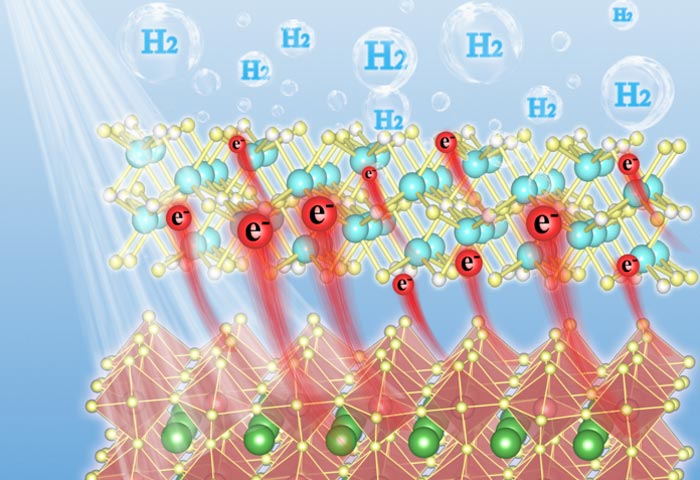Expediting H2-evolution over MAPbI3

Hydrogen evolution over Mo2C@MAPbI3
Credit: Mechanistic of Mo2C@MAPbI3, Shanghai Key Lab of Chemical Assessment and Sustainability, School of Chemical Science and Engineering, Tongji University
… with a non-noble metal cocatalyst Mo2C under visible light.
Nanomaterials frontier towards hydrogen energy. Halide perovskites have been emerging as promising photocatalytic materials for H2-evolution from water due to their outstanding photoelectric properties. However, the lack of proper surface reactive sites greatly hinders the photocatalytic potential of these fascinating compounds. Here, Mo2C nanoparticles have been anchored onto methylammonium lead iodide (MAPbI3) as a non-noble-metal cocatalyst to promote H2-evolution reactions.
They published their work on May. 28 in Energy Material Advances.
“Photocatalytic water splitting has been considered as a promising route to store solar energy into hydrogen energy,” said paper author Xiaoxiang Xu, professor with the Shanghai Key Lab of Chemical Assessment and Sustainability, School of Chemical Science and Engineering, Tongji University. “Currently, halide perovskites have been gained great interest as photocatalysts for H2-evolution reactions, but they are normally deficient in surface reactive sites where photocarriers cannot be promptly transferred for surface redox reactions.”
Xu explained that the extremely acidic environment needed to stabilize halide perovskites in an aqueous solution restrains the choices of H2-evolution cocatalyst that can be deposited.
“The noble-metal cocatalyst Pt has been introduced to promote H2-evolution reactions but is still unsatisfactory probably due to the poor Pt/halide perovskite interfaces,” Xu said. “Robust non-noble-metal-based cocatalysts have gained serious attention as alternatives to noble-metal cocatalyst.”
However, their connections with halide perovskites are generally very weak often due to structural mismatch thereby preventing fast charge migrations from halide perovskites to these cocatalysts. According to Xu, Mo2C, a promising low-cost electrocatalyst for H2-evolution reaction, exhibits excellent electrocatalytic activity over a wide pH range thereby serving as a potential candidate cocatalyst for photocatalytic H2-evolution.
Mo2C is one of a few compounds that are stable in strong acids, Xu said, rendering it an excellent alternative cocatalyst for halide perovskites which are stabilized in strong acid during photocatalytic reactions, e.g. HBr and HI aqueous solution.
“The opposite Zeta potentials between Mo2C and MAPbI3 ensure firm interconnections between these compounds,” Xu said. “In this paper, we illustrated recent research expediting H2-evolution over MAPbI3 with a non-noble metal cocatalyst Mo2C under visible light.”
“We have successfully loaded Mo2C nanoparticles onto MAPbI3 by an electrostatic-assembly method to fabricate Mo2C@MAPbI3 composites,” Xu said.
“The Mo2C nanoparticles are found to be homogeneously and firmly anchored at the surface of MAPbI3,” Xu said. “Thanks to the strong interconnections between Mo2C and MAPbI3, Mo2C@MAPbI3 composites exhibit superior photocatalytic activity for H2-evolution from water which clearly surpasses pristine MAPbI3 and Pt deposited MAPbI3 under the same testing conditions.”
“Further analysis suggests that Mo2C nanoparticles not only facilitate charge separation in MAPbI3 but also substantially expedite interfacial charge transfer for water reduction reactions,” Xu said. “These findings justify the Mo2C as an efficient non-noble-metal cocatalyst for halide perovskite photocatalysts that work under a highly acidic environment.”
The National Natural Science Foundation of China (Grant No. 51972233, 52172225), Natural Science Foundation of Shanghai (Grant No. 19ZR1459200), Science and Technology Commission of Shanghai Municipality (19DZ2271500) and the Fundamental Research Funds for the Central Universities supported this work.
Reference
Authors: Jinxing Yu and Xiaoxiang Xu
Title of original paper: Expediting H2 Evolution over MAPbI3 with a Nonnoble Metal Cocatalyst Mo2C under Visible Light
Journal: Energy Material Advances
DOI: https://doi.org/10.34133/2022/9836095
Affiliations:
Shanghai Key Lab of Chemical Assessment and Sustainability, School of Chemical Science and Engineering, Tongji University, Shanghai 200092, China
About the Author:
Dr. Xiaoxiang Xu is a professor in School of Chemical Science and Engineering, Tongji University. He received his PhD degree from the University of St Andrews in 2010. From 2009 to 2013, he worked as a postdoc at the University of St Andrews. He joined the Tongji University in 2014. His research interest includes photocatalytic materials, environmental remediation, proton conductors and fuel cells, etc. He has co-authored more than 110 peer-reviewed papers.
Journal: Energy Material Advances
DOI: 10.34133/2022/9836095
Method of Research: Experimental study
Subject of Research: Not applicable
Article Title: Expediting H2 Evolution over MAPbI3 with a Nonnoble Metal Cocatalyst Mo2C under Visible Light
Article Publication Date: 28-May-2022
COI Statement: The authors declare that there is no conflict of interest regarding the publication of this article.
Media Contact
Ning Xu
Beijing Institute of Technology Press Co., Ltd
xuning1907@foxmail.com
Original Source
https://spj.sciencemag.org/journals/energymatadv/2022/9836095/
All latest news from the category: Materials Sciences
Materials management deals with the research, development, manufacturing and processing of raw and industrial materials. Key aspects here are biological and medical issues, which play an increasingly important role in this field.
innovations-report offers in-depth articles related to the development and application of materials and the structure and properties of new materials.
Newest articles

Innovative 3D printed scaffolds offer new hope for bone healing
Researchers at the Institute for Bioengineering of Catalonia have developed novel 3D printed PLA-CaP scaffolds that promote blood vessel formation, ensuring better healing and regeneration of bone tissue. Bone is…

The surprising role of gut infection in Alzheimer’s disease
ASU- and Banner Alzheimer’s Institute-led study implicates link between a common virus and the disease, which travels from the gut to the brain and may be a target for antiviral…

Molecular gardening: New enzymes discovered for protein modification pruning
How deubiquitinases USP53 and USP54 cleave long polyubiquitin chains and how the former is linked to liver disease in children. Deubiquitinases (DUBs) are enzymes used by cells to trim protein…



